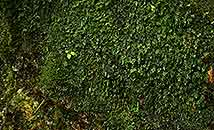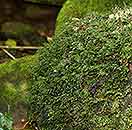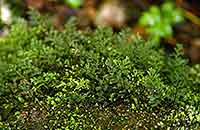Polyphlebium borbonicum (Bosch.) Ebihara & Dubuisson
Synonyms |
Trichomanes borbonicum Bosch |
|---|---|
Common name |
|
Description |
Rhizome creeping, filiform; covered with long brown unbranched hairs, hairs up to 1 mm long. Fronds spaced 1-4 cm apart. Stipe 6-30(-65) mm long, narrowly winged in distal half to three quarters, glabrous except near very base. Rhachis winged. Lamina 25-65 × 15-50 mm, ovate to narrowly lanceolate in outline, base truncate to broadly cuneate, 2- or 3-pinnatifid; pinnae 6-14 on each side, up to 3.5 x 1 cm, spreading at 45 to 90° from the rhachis; ultimate lobes linear, entire, rounded, false veins or drying fold absent. Sori borne in the upper half of the frond, indusium narrowly obconical, about twice as long as wide, narrowly winged by the lamina for its whole length, soral lips flared, receptacle exserted up to 7 mm. |
Notes | A distinct form possessing much longer, branched root hairs, a semiflabbellate lamina and a false intramarginal vein occurs in Swaziland and Zimbabwe. These plants occupy a slightly drier forest type than is typical for P. borbonicum.
|
Derivation | borbonicum: of Bourbon; this fern was first described from Bourbon, the original name for Réunion. |
Habitat | Moist deeply shaded montane forest, by streams. |
Distribution worldwide | Africa, Madagascar and the Mascarenes. |
Distribution in Africa |
Cameroon, Dem. Republic of Congo, Equatorial Guinea (incl. Bioko), Ethiopia, Ghana, Guinea, Ivory Coast, Kenya, Liberia, Malawi, Mozambique, Rwanda, South Africa, Swaziland, Tanzania , Zimbabwe. |
Growth form |
Epiphytic, lithophytic. |
Literature |
|


